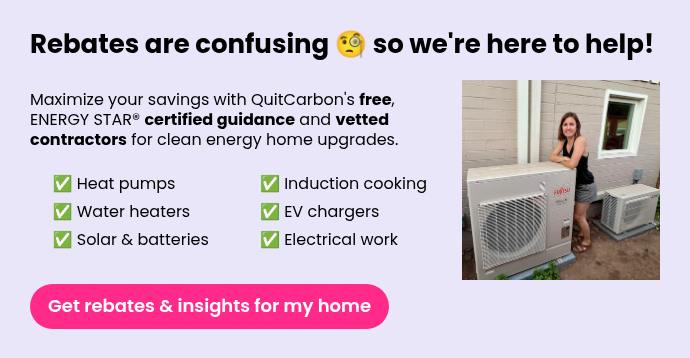What federal rebates are available from the Inflation Reduction Act?
There are still federal, state, local, and utility rebates available. QuitCarbon tracks them all and can help you identify those you're eligible for.
November 2025 update: Rebates valued up to $8,000 are now available from the HEEHRA rebate program for single-family homes for new applicants. QuitCarbon is maintaining a help page dedicated to this program relaunch. Act quickly, as these rebates won't last long!
HEEHRA funding has reopened and will last through the end of February, 2026. In addition, you can claim federal tax credits for home energy upgrades for projects completed by December 31, 2025. Often, you can combine these federal incentives with robust state and local rebates to significantly lower the cost of your home energy upgrade. Time to claim these incentives is limited, making now perhaps the best time to install new appliances that improve home comfort and save you money.
Combining Rebates and Tax Credits for Maximum Savings
State and local rebate programs can be combined with HEEHRA and the Energy Efficient Home Improvement Credit (the 25C tax credit), offering significant cost reductions for home upgrades. Here's how it works:
- Rebates are applied as discounts to the purchase price of eligible appliances or home improvements. These rebates are not taxable.
- After applying a rebate, you can claim the 25C tax credit on the reduced cost of the upgrade. For example, if you receive a $1,500 rebate on a $5,000 heat pump installation, your tax credit would apply to the remaining $3,500. With the 25C tax credit covering 30% of eligible costs, you could get a credit of $1050, further reducing the cost to $2,450.
Important limitations:
- 25C tax credits are capped at $3,200. $2,000 can be claimed for either a Heat Pump or Heat Pump Water Heater, and $1,200 can be claimed for other qualifying energy efficiency home improvements.
- The combination of rebates and tax credits cannot exceed the total cost of the project.
- You may not carry forward unused tax credits from 25C to future years, so make sure that you are maximizing your benefit in the current year.
Start Planning Now
Although the rebates won’t be retroactive, it’s smart to start planning your projects now. QuitCarbon will keep you informed of state-specific details and help you take full advantage of the savings once these programs launch. Reach out to our team to get started on your path to an electrified, energy-efficient home.

